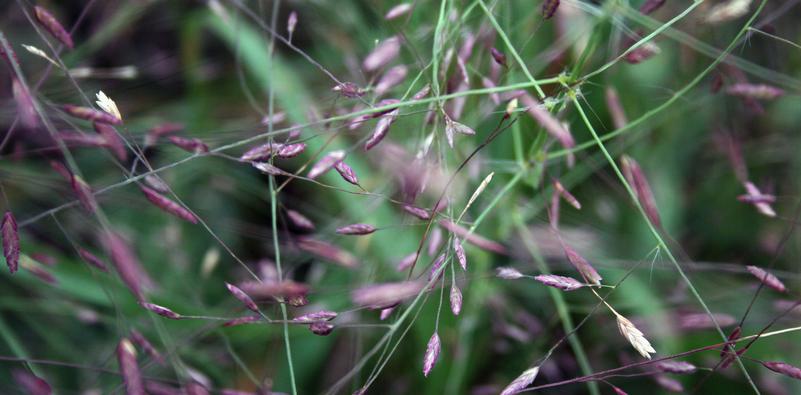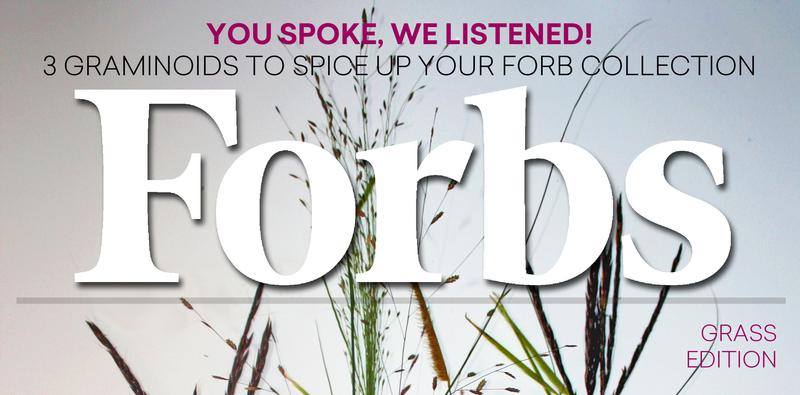Good Golly, Great Grasses!
It’s been a while since we’ve taken a meander through our grassy knolls... or, at the very least, the masses of grasses we have patiently waiting in their production houses for their forever homes. With the demand for native species increasing, we wanted to take the time to highlight some wonderful graminoid options for the Mid-Atlantic and beyond. Move over, Miscanthus!
Andropogon gerardii ‘Blackhawks’ | bluestem
Andropogon gerardii ‘Blackhawks’ is a dark-leaved selection, as its name suggests, that commits to a seductive, heavily saturated complexion imbued with burgundies, wine reds, lustrous midnight blues, purples, and greens. Atop the medley of colorful blades, maroon inflorescences sprinkled with tiny golden anthers erupt towards the end of midsummer. Despite the limited distribution of Andropogon gerardii along the eastern United States corridor, isolated populations make up swaths of rare Piedmont prairies and it’s been found that pre-Colonial settlement, bluestem had quite a large distribution across much of the Carolinas. Expectedly, modern agricultural practices as well as the inevitable upheaval of natural resources and disruption of natural processes such as periodic burns have assisted the disappearance of bluestems and innumerable other native grass and forb species. Adding bluestem back into the landscape and into our garden spaces helps to ensure the success of future Andropogon gerardii populations while also supporting soil stabilization – this species is fantastic for naturalizing or restoring many different landscapes with many different soil conditions. With Andropogon gerardii ‘Blackhawks’, the ecological benefits are only the tip of the iceberg. The ornamental qualities are not to be undervalued – the sultry purple-black foliage and dark burgundy inflorescences are part of a unique plant palette that is considerably rare on the native plant spectrum.
Eragrostis spectabilis | purple lovegrass
I might be a bit biased when it comes to this selection, simply because it may be one of the most charming grasses on the nursery. Eragrostis spectabilis knows how to put on a show with its misty plumes of soft pinkish-purple inflorescences that appear almost cloud-like when grouped together. The tiny, individual seedheads that make up each inflorescence act as a textural backdrop to broader-leaved perennials and shrubs, and also make a lovely addition to fresh or dried cut flower arrangements. While this warm season grass is native to a large chunk of North America excluding most of the far West, it’s learned to adapt to urbanized conditions and can be used where road salt, compaction, or the general muck-and-mire of day-to-day human activities become burdensome to more sensitive plant species. Not purple lovegrass! This hardy selection is capable of thriving in some of the most adverse of conditions, such as rarely-maintained hellstrips, or along roadsides, driveways, or bordering curbside (and seaside!) gardens. In fact, Eragrostis spectabilis has found to be highly tolerant of saline solution in a 2019 study, showing only minimal foliar damage when exposed to an EC of 5.0 ds/m-1 – pretty spectacular when you consider the optimal EC reading for supporting healthy plants usually falls somewhere between 0.8-1.8 0 ds/m-1 and almost never exceeds 2.8 ds/m-1. Don’t let the chemistry jargon fool you – that’s an incredibly high salt tolerance! That being said, if purple lovegrass isn’t on your coastal planting list, it’s time to reconsider!
Bouteloua gracilis ‘Blonde Ambition’ | blue grama
This is one of those grasses that tends to draw quite a bit of attention to itself in the landscape, especially when massed. The curious, eyebrow-like inflorescences, which emerge chartreuse, transform to bright blonde tones and hover horizontally above wiry blue-green stems. The species blue grama is a key player in natural upland prairie and grassland habitats as one of the predominant grasses, often coinciding with our aforementioned friends, the bluestems (Andropogon sp.). Bouteloua gracilis has shown incredible drought tolerance even during moderately long periods of time, and has been found to recover more easily than some of its grassland companions. Interestingly, this species does not reside solely in prairie-grassland habitats, but can be found across a whopping 28 of the contiguous United States as well as up into parts of Canada. The versatility of blue grama grass makes it ideal for a number of landscape conditions, including use as a lawn alternative or as part of a green roof planting. Due to its preference for good drainage and even its tolerance of poor soils, blue grama grass makes an excellent choice for stabilizing drier soils prone to erosion. The whimsy inspired by the peculiar seedheads, however, is perfect for interactive spaces such as children’s and sensory gardens, providing visual delight and inviting visitors to touch and explore their unusual, bristly inflorescences.
What are the benefits of adding grasses to the landscape?
-Vertical ornamental element
-Winter interest with seedheads
-Ability to interplant cool and warm season grasses for consistent, year-round color
-Soil stabilization and erosion prevention
-Stormwater management and water conservation
-Nesting material for birds and shelter for small animals and insects
Get off your grass and add these awesome selections to your next order! Make sure to visit our website for all of our available graminoid selections before the busy fall season hits!
USPP27949P2 - Andropogon gerardii plant named ‘Blackhawks’ - Google Patents
Andropogon gerardii 'Blackhawks' PP27949 | Walters Gardens, Inc.
Eragrostis spectabilis (Purple Lovegrass): Minnesota Wildflowers
Bouteloua gracilis ‘Blonde Ambition’ PP22048 (hoffmannursery.com)
'Blonde Ambition' Blue Grama Grass: 2011 Plant Of The Year | High Country Gardens
Ecological Studies of Blue Grama Grass (Bouteloua gracilis) (fhsu.edu)
Wang, Y., Sun, Y., Niu, G., Deng, C., Wang, Y., & Gardea-Torresdey, J. (2019). Growth, Gas Exchange, and Mineral Nutrients of Ornamental Grasses Irrigated with Saline Water. HortScience horts, 54(10), 1840-1846. Retrieved Aug 9, 2024, from https://doi.org/10.21273/HORTSCI13953-19
See all our Grasses
Eragrostis spectabilis

